Research on Pore-Fracture Characteristics and Adsorption Performance of Main Coal Seams in Lvjiatuo Coal Mine
Abstract
:1. Introduction
2. Sample Collection and Experimental Methods
2.1. Sample Collection
2.2. Experimental Method and Theory
2.2.1. LT-N2GA Experiment
2.2.2. MIP Experiment
2.2.3. μ-CT Experiment
2.2.4. Methane Isothermal Adsorption Experiment
2.2.5. Fractal Theory
3. Results and Discussion
3.1. Pore Structure Characteristics of LT-N2GA
3.1.1. LT-N2GA Adsorption-Desorption Isotherm
3.1.2. Specific Surface Area and Pore Volume Pore Size Distribution Characteristics
3.2. Pore Structure Characteristics of MIP
3.2.1. Characteristics of MIP Curve
3.2.2. Pore diameter distribution characteristics
3.3. Characteristics of Pore and Fracture Structure Based on μ-CT Experiment
3.4. Pore Adsorption Characteristics Based on Methane Isothermal Adsorption Experiment
3.5. Influence of Pore-Fracture Structure of Coal Reservoir on Gas Adsorption, Diffusion and Seep age
4. Conclusions
- (1)
- The adsorption–desorption curves of all coal samples are of type Ⅲ, and the pore development types of all coal seams are similar. Micropores and transition pores contribute most of the pore volume and pore specific surface area. By comparing the pore structure characteristics of all coal seams, the macropores of the No. 9 coal seam are the most developed, and the connectivity is also the best, providing channel sfor gas diffusion and seepage. The micropores of the No. 7, 8, 11 and 12 coal seams are more developed, providing the main gas adsorption place.
- (2)
- The three-dimensional pore network structure of coal is intuitively displayed through μ-CT experiments, and the connected pores and isolated pores are distinguished. The connectivity provides a basis for the comparison of gas adsorption, diffusion and seepage capacity in coal. The heterogeneity of coal pores is quantitatively characterized by fractal theory. The more micropores that are developed, the higher the fractal dimension and the higher the porosity heterogeneity are. The gas adsorption capacity of all coal seams is compared through the methane isothermal adsorption experiment.
- (3)
- Based on previous research and the pore structure characteristics of all coal seams in this paper, the influence of the pore-fracture structure of coal reservoirs on gas adsorption, diffusion and seepage is discussed, and finally the gas outburst risk of each coal seam is predicted. The prediction conclusion shows that abnormal gas emissions and gas outbursts are most likely to occur in the No.12 coal seam. The experimental results have important guiding significance for gas prevention and control in deep mining.
Author Contributions
Funding
Data Availability Statement
Conflicts of Interest
References
- Liu, P.; Liu, A.; Zhong, F.; Jiang, Y.; Li, J. Pore/fracture structure and gas permeability alterations induced by ultrasound treatment in coal and its application to enhanced coalbed methane recovery. J. Pet. Sci. Eng. 2021, 205, 108862. [Google Scholar] [CrossRef]
- Qin, Y.; Zhao, Z.; Xu, H.; Liu, W.; Wu, F.; Zhou, Y.; Duan, W. Numerical solution of three mathematical models of gas adsorption in coal particle based on finite difference method. Fuel 2022, 308, 122036. [Google Scholar] [CrossRef]
- Yang, N.; Hu, G.; Zhu, J.; Duan, H.; Wang, T.; Li, Y. Evolution of pore-fracture structure and permeability of coal by microwave irradiation under uniaxial compression. J. Nat. Gas Sci. Eng. 2022, 107, 104759. [Google Scholar] [CrossRef]
- Yin, T.T.; Liu, D.M.; Cai, Y.D.; Zhou, Y.F. Methane adsorption constrained by pore structure in high-rank coals using FESEM, CO2 adsorption, and NMRC techniques. Energy Sci. Eng. 2019, 7, 255–271. [Google Scholar] [CrossRef] [Green Version]
- Liu, D.; Qiu, F.; Liu, N.; Cai, Y.; Guo, Y.; Zhao, B.; Qiu, Y. Pore structure characterization and its significance for gas adsorption in coals: A comprehensive review. Unconv. Resour. 2022, 2, 139–157. [Google Scholar] [CrossRef]
- Liu, D.; Yao, Y.; Yuan, X.; Yang, Y. Experimental evaluation of the dynamic water-blocking effect in coalbed methane reservoir. J. Pet. Sci. Eng. 2022, 217, 110887. [Google Scholar] [CrossRef]
- Pan, J.; Zhu, H.; Hou, Q.; Wang, H.; Wang, S. Macromolecular and pore structures of Chinese tectonically deformed coal studied by atomic force microscopy. Fuel 2015, 139, 94–101. [Google Scholar] [CrossRef]
- Shi, X.; Pan, J.; Pang, L.; Wang, R.; Li, G.; Tian, J.; Wang, H. 3D microfracture network and seepage characteristics of low-volatility bituminous coal based on nano-CT. J. Nat. Gas Sci. Eng. 2020, 83, 103556. [Google Scholar] [CrossRef]
- Wu, M.; Li, H.; Wang, L.; Yang, X.; Dai, C.; Yang, N.; Li, J.; Wang, Y.; Yu, M. μCT quantitative assessment of the pore–fracture structures and permeability behaviors of long-flame coal treated by infrared rapid heating. Energy 2023, 274, 127308. [Google Scholar] [CrossRef]
- Hu, L.; Zhu, Y.; Zhang, J. Analysis of Gas Geological Control Factors for Lvjiatuo Mine. Saf. Coal Mines 2016, 47, 182–185. [Google Scholar]
- Hu, C. Study on Deep Gas Geological Law and Gas Prediction in Lvjiatuo Mine; China University of Mining and Technology: Xuzhou, China, 2021. [Google Scholar]
- Wei, Q.; Li, X.; Zhang, J.; Hu, B.; Zhu, W.; Liang, W.; Sun, K. Full-size pore structure characterization of deep-buried coals and its impact on methane adsorption capacity: A case study of the Shihezi Formation coals from the Panji Deep Area in Huainan Coalfield, Southern North China. J. Pet. Sci. Eng. 2019, 173, 975–989. [Google Scholar] [CrossRef]
- Pan, R.; Li, C.; Yu, M.; Xiao, Z.; Fu, D. Evolution patterns of coal micro-structure in environments with different temperatures and oxygen conditions. Fuel 2020, 261, 116425. [Google Scholar] [CrossRef]
- Zhang, Y.; Niu, K.; Du, W.; Zhang, J.; Wang, H.; Zhang, J. A method to identify coal spontaneous combustion-prone regions based on goaf flow field under dynamic porosity. Fuel 2021, 288, 119690. [Google Scholar] [CrossRef]
- Chattaraj, S.; Upadhyay, R.; Mohanty, D.; Halder, G.; Kumar, T. Evaluating production behaviour of CBM wells from Raniganj Coalfield through reservoir characterization under constrained field data conditions. J. Nat. Gas Sci. Eng. 2021, 92, 103969. [Google Scholar] [CrossRef]
- Vasilenko, T.; Kirillov, A.; Islamov, A.; Doroshkevich, A. Study of hierarchical structure of fossil coals by small-angle scattering of thermal neutrons. Fuel 2021, 292, 120304. [Google Scholar] [CrossRef]
- Sun, Z.; Huang, B.; Liu, Y.; Jiang, Y.; Zhang, Z.; Hou, M.; Li, Y. Gas-phase production equation for CBM reservoirs: Interaction between hydraulic fracturing and coal orthotropic feature. J. Pet. Sci. Eng. 2022, 213, 110428. [Google Scholar] [CrossRef]
- Cai, Y.; Li, Q.; Liu, D.; Zhou, Y.; Lv, D. Insights into matrix compressibility of coals by mercury intrusion porosimetry and N2 adsorption. Int. J. Coal Geol. 2018, 200, 199–212. [Google Scholar] [CrossRef] [Green Version]
- Li, Y.; Yang, J.; Pan, Z.; Tong, W. Nanoscale pore structure and mechanical property analysis of coal: An insight combining AFM and SEM images. Fuel 2020, 260, 116352. [Google Scholar] [CrossRef]
- Liu, N.; Sun, L.; Qin, B.; Zhang, S.; Du, W. Evolution of pore and fracture of coal under heating–freezing effects: An experimental study. Fuel 2021, 306, 121618. [Google Scholar] [CrossRef]
- Zheng, S.; Yao, Y.; Sang, S.; Liu, D.; Wang, M.; Liu, S. Dynamic characterization of multiphase methane during CO2-ECBM: An NMR relaxation method. Fuel 2022, 324, 124526. [Google Scholar] [CrossRef]
- Liu, P.; Nie, B.; Zhao, Z.; Li, J.; Yang, H.; Qin, C. Permeability of micro-scale structure in coal: Insights from μ-CT image and pore network modelling. Gas Sci. Eng. 2023, 111, 204931. [Google Scholar] [CrossRef]
- Wang, L.; Cheng, J.; Jin, Z.; Sun, Q.; Zou, R.; Meng, Q.; Liu, K.; Su, Y.; Zhang, Q. High-pressure hydrogen adsorption in clay minerals: Insights on natural hydrogen exploration. Fuel 2023, 344, 127919. [Google Scholar] [CrossRef]
- Fang, H.; Sang, S.; Liu, S.; Du, Y. Methodology of three-dimensional visualization and quantitative characterization of nanopores in coal by using FIB-SEM and its application with anthracite in Qinshui basin. J. Pet. Sci. Eng. 2019, 182, 106285. [Google Scholar] [CrossRef]
- Chen, S.B.; Gong, Z.; Li, X.Y.; Wang, H.J.; Wang, Y.; Zhang, Y.K. Pore structure and heterogeneity of shale gas reservoirs and its effect on gas storage capacity in the Qiongzhusi Formation. Geosci. Front. 2021, 12, 101244. [Google Scholar] [CrossRef]
- Li, J.; Zhang, J.; Huang, K.; Li, W. Dynamic Variation on Water Micro-occurrence in Low-Rank Coals by a Low-Field Nuclear Magnetic Resonance Experiment: A Case Study of the No. 7 Coal Seam in Kongzhuang Coal Mine. Energy Fuels 2022, 36, 9066–9079. [Google Scholar] [CrossRef]
- Li, Y.; Song, D.; Liu, S.; Ji, X.; Hao, H. Evaluation of pore properties in coal through compressibility correction based on mercury intrusion porosimetry: A practical approach. Fuel 2021, 291, 120130. [Google Scholar] [CrossRef]
- Mahamud, M.M.; Menéndez, J.M.; Álvarez, A. Fractal analysis of CO2 and N2 adsorption data to assess textural changes during char gasification. Fuel Process. Technol. 2019, 189, 15–27. [Google Scholar] [CrossRef]
- Washburn; Edward, W. The Dynamics of Capillary Flow. Phys. Rev. 1921, 17, 273–283. [Google Scholar] [CrossRef] [Green Version]
- Chengyang, W.; Shixiong, H.; Wenjing, S.; Wei, C. Fractal dimension of coal particles and their CH4 adsorption. Int. J. Min. Sci. Technol. 2012, 22, 855–858. [Google Scholar] [CrossRef]
- Liu, X.; Nie, B. Fractal characteristics of coal samples utilizing image analysis and gas adsorption. Fuel 2016, 182, 314–322. [Google Scholar] [CrossRef]
- Li, Z.; Ren, T.; Li, X.; Qiao, M.; Yang, X.; Tan, L.; Nie, B. Multi-scale pore fractal characteristics of differently ranked coal and its impact on gas adsorption. Int. J. Min. Sci. Technol. 2023, 33, 389–401. [Google Scholar] [CrossRef]
- Yao, Y.; Liu, D.; Tang, D.; Tang, S.; Huang, W. Fractal characterization of adsorption-pores of coals from North China: An investigation on CH4 adsorption capacity of coals. Int. J. Coal Geol. 2008, 73, 27–42. [Google Scholar] [CrossRef]
- Wang, M.; Xue, H.; Tian, S.; Wilkins, R.W.T.; Wang, Z. Fractal characteristics of Upper Cretaceous lacustrine shale from the Songliao Basin, NE China. Mar. Pet. Geol. 2015, 67, 144–153. [Google Scholar] [CrossRef]
- Sun, L.; Zhang, C.; Wang, G.; Huang, Q.; Shi, Q. Research on the evolution of pore and fracture structures during spontaneous combustion of coal based on CT 3D reconstruction. Energy 2022, 260, 125033. [Google Scholar] [CrossRef]
- Sing, K.S.W. Reporting physisorption data for gas/solid systems with special reference to the determination of surface area and porosity (Recommendations 1984). Pure Appl. Chem. 1985, 57, 603–619. [Google Scholar] [CrossRef]
- Hodot, B. Outburst of Coal and Coalbed Gas; China Industry Press: Beijing, China, 1966; pp. 23–25. [Google Scholar]
- Ortiz, L.; Kuchta, B.; Firlej, L.; Roth, M.W.; Wexler, C. Methane adsorption in nanoporous carbon: The numerical estimation of optimal storage conditions. Mater. Res. Express 2016, 3, 055011. [Google Scholar] [CrossRef]
- Moore, T.A. Coalbed methane: A review. Int. J. Coal Geol. 2012, 101, 36–81. [Google Scholar] [CrossRef]

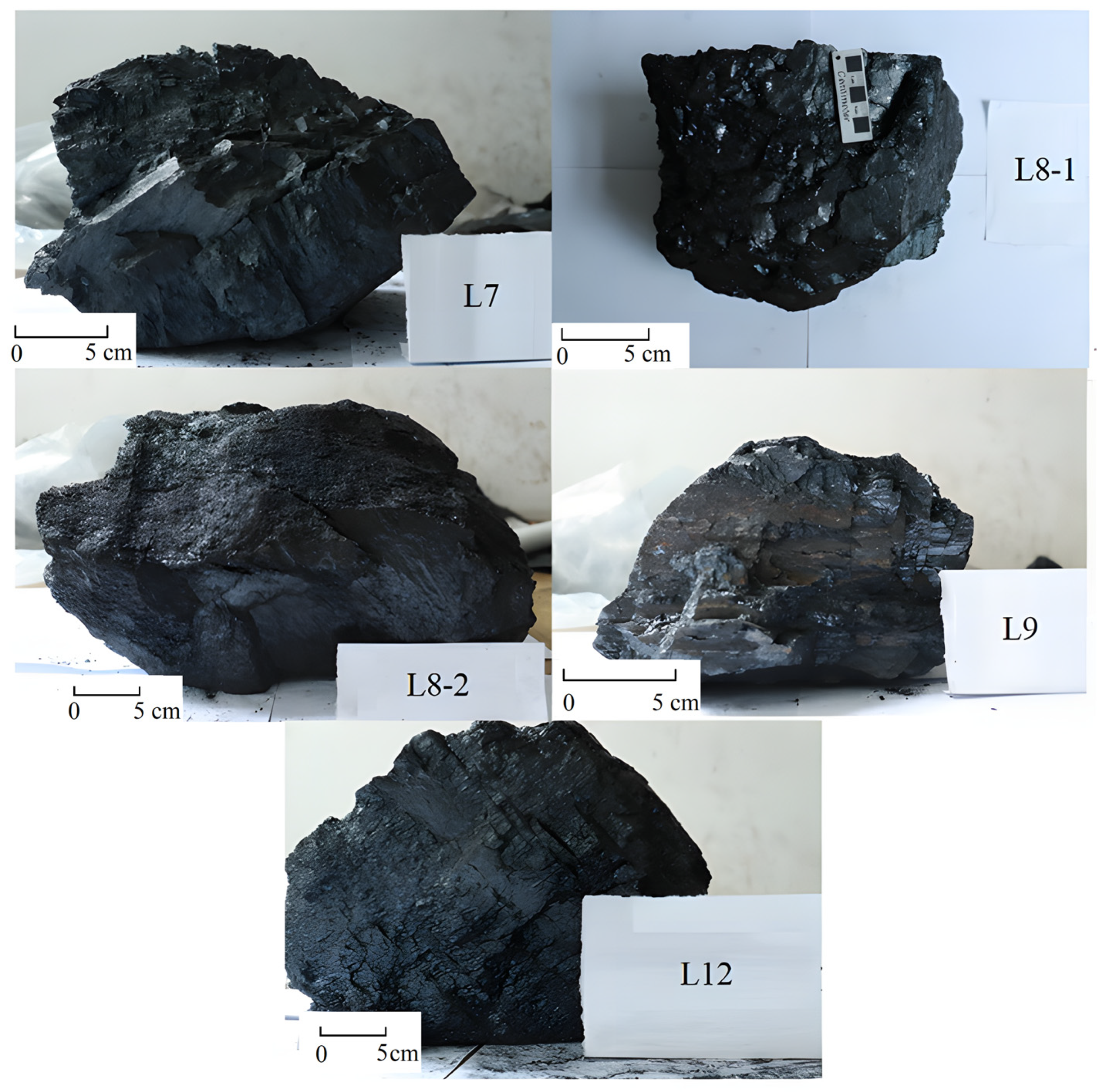

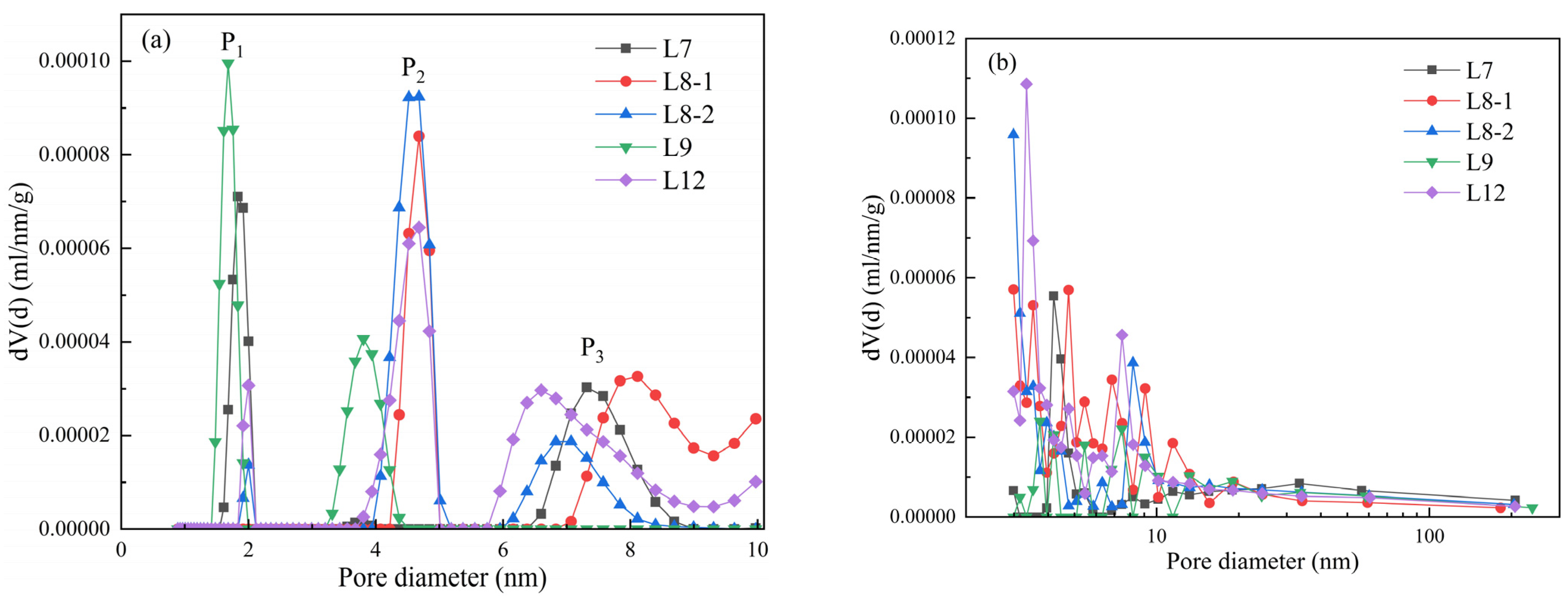
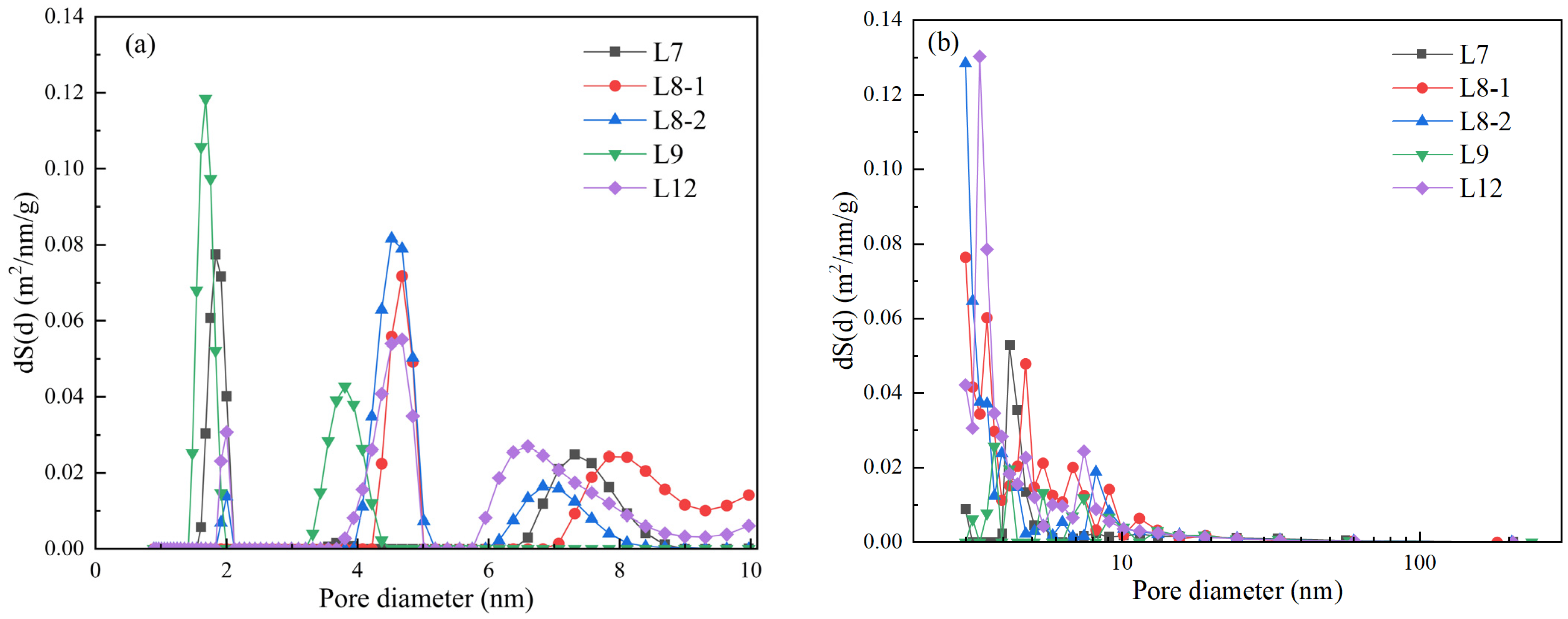
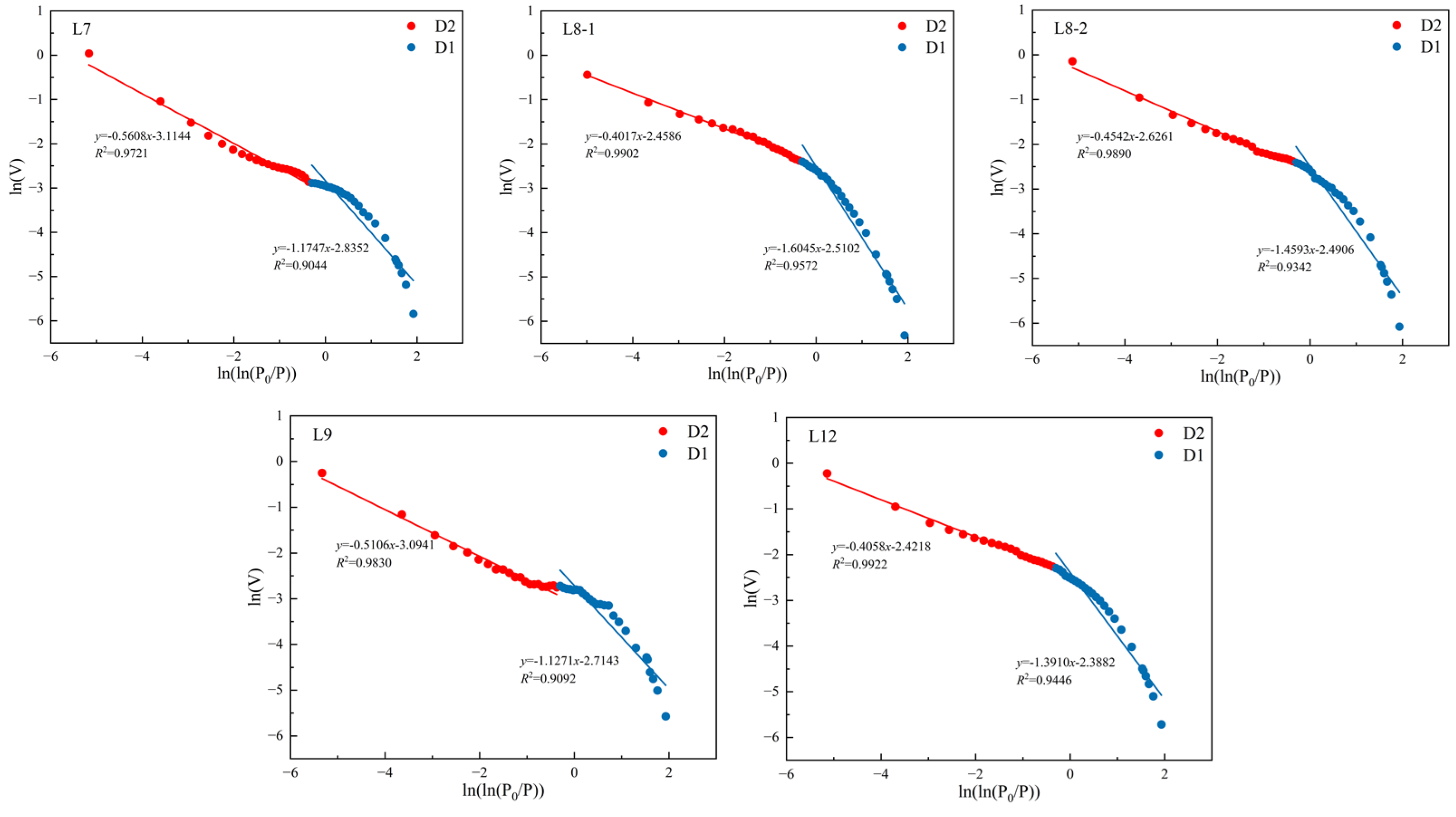
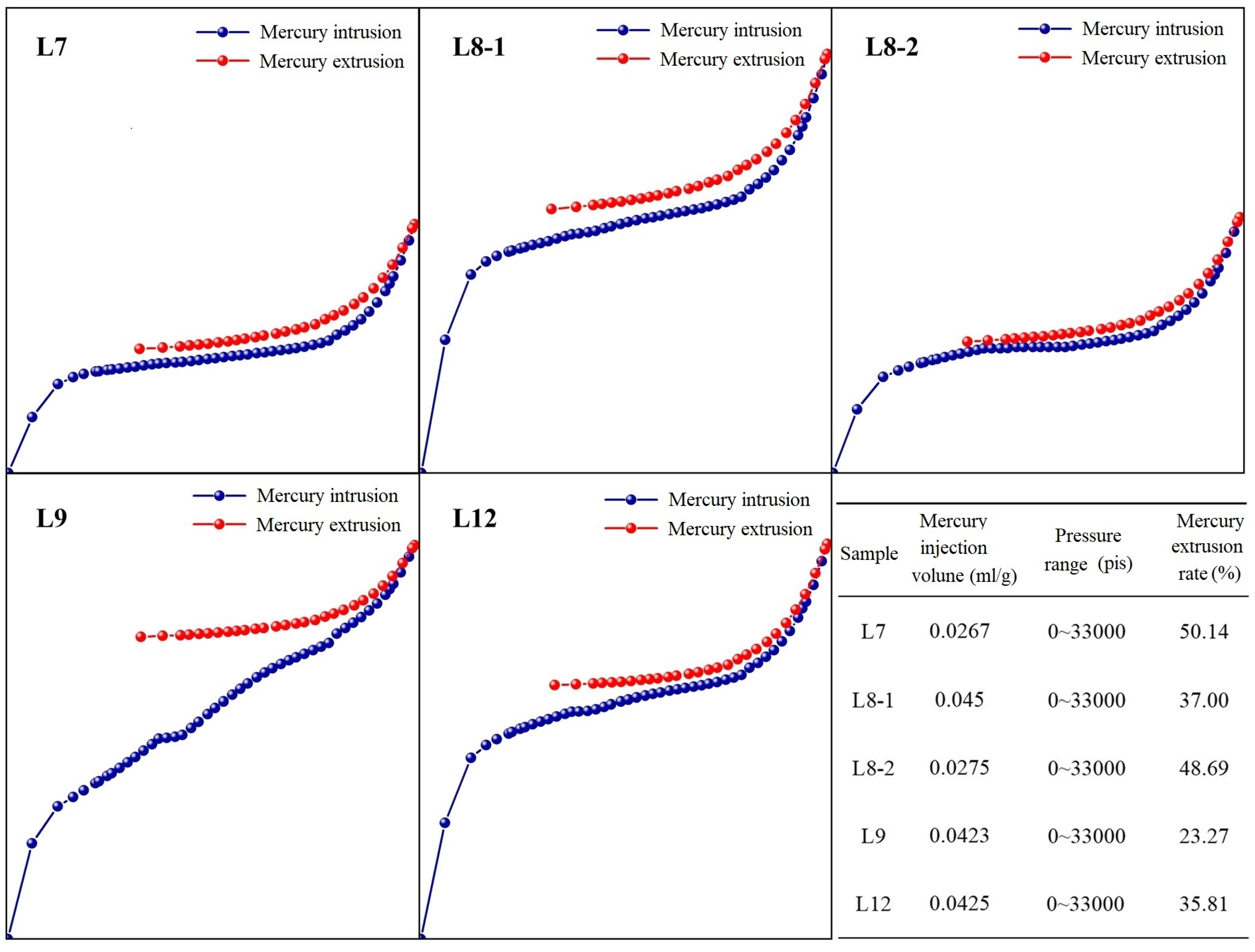

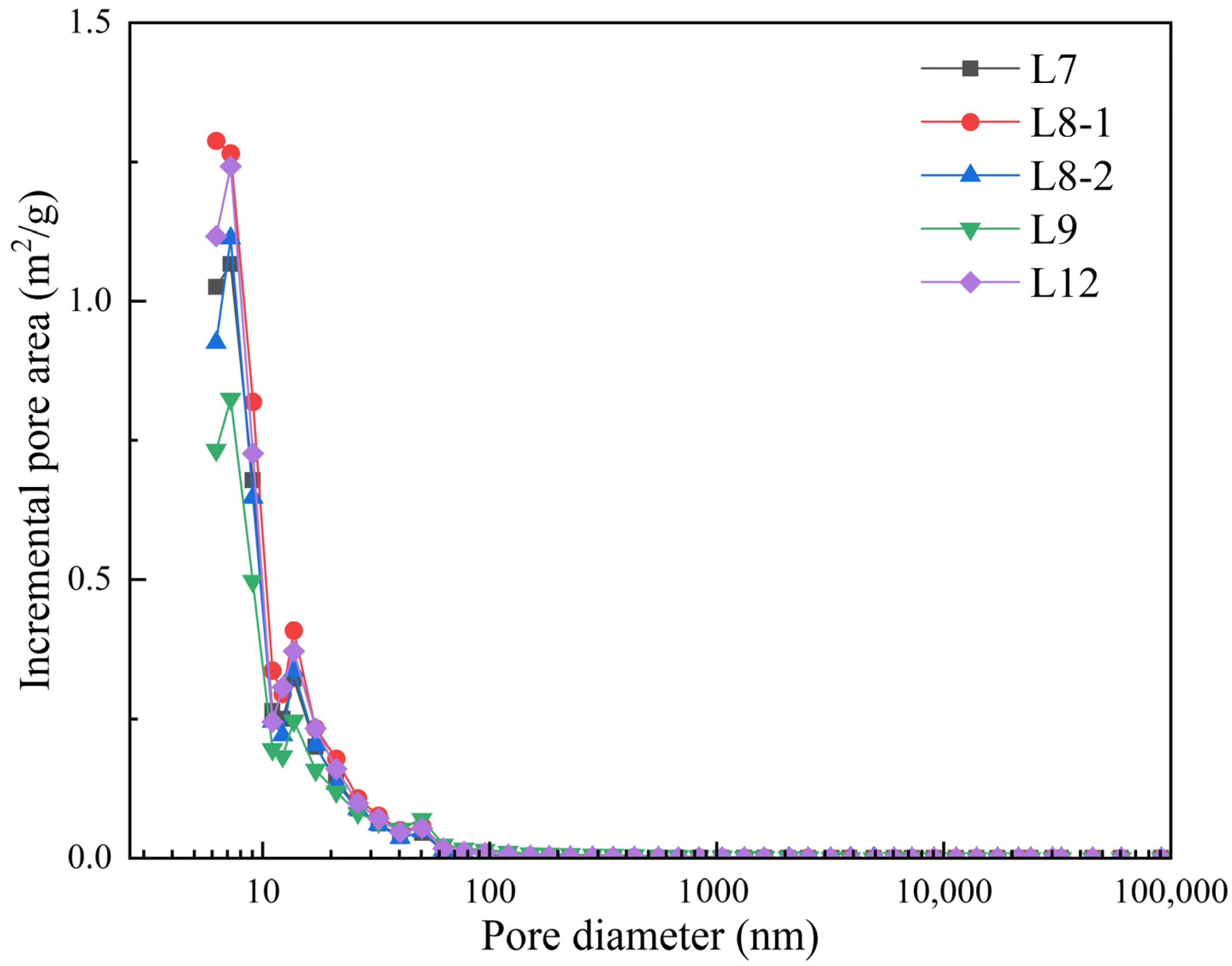
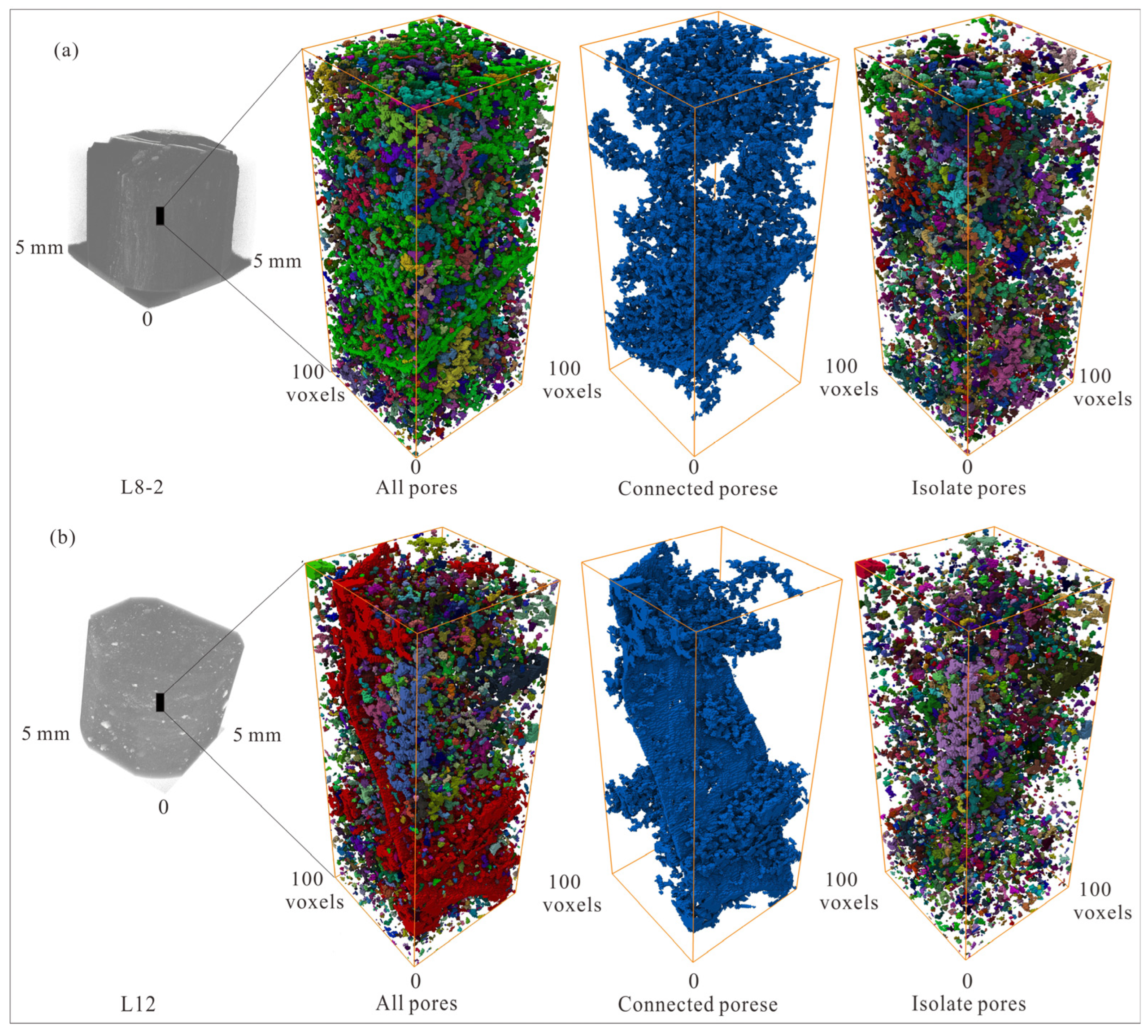



| Sample ID | Ro,max (%) | Vitrinite (%) | Inertinite (%) | Exinite (%) | Mineral (%) |
|---|---|---|---|---|---|
| L7 | 1.49 | 52.82 | 30.14 | 15.02 | 2.02 |
| L8-1 | 1.48 | 54.88 | 26.05 | 17.03 | 2.04 |
| L8-2 | 1.55 | 58.04 | 21.38 | 16.31 | 4.27 |
| L9 | 1.53 | 71.12 | 15.21 | 10.51 | 3.16 |
| L12 | 1.42 | 75.13 | 13.85 | 4.83 | 6.19 |
| Parameters | Timing/ms | Average | Skip | Binning | Sensitivity | Vsensor | Images |
|---|---|---|---|---|---|---|---|
| nm | 1000 | 2 | 1 | 1× | 1000 | 1 | 1500 |
| μm | 1000 | 2 | 1 | 1 × 1 | 1000 | 1 | 1500 |
| Sample ID | Average Pore Diameter (nm) | Total SSA (m2/g) | Total Pore Volume (mL/g) |
|---|---|---|---|
| L7 | 4.01 | 0.16 | 0.0016 |
| L8-1 | 1.85 | 0.22 | 0.0010 |
| L8-2 | 2.62 | 0.21 | 0.0013 |
| L9 | 2.74 | 0.18 | 0.0012 |
| L12 | 2.08 | 0.24 | 0.0012 |
| Sample | P/P0 < 0.5 | P/P0 > 0.5 | ||||
|---|---|---|---|---|---|---|
| Fitting Equation | R2 | D1 | Fitting Equation | R2 | D2 | |
| L7 | y = −1.17x − 2.84 | 0.90 | 1.82 | y = −0.56x − 3.1 | 0.97 | 2.44 |
| L8-1 | y = −1.60x − 2.51 | 0.96 | 1.39 | y = −0.40x − 2.46 | 0.99 | 2.59 |
| L8-2 | y = −1.46x − 2.49 | 0.93 | 1.54 | y = −0.45x − 2.63 | 0.99 | 2.55 |
| L9 | y = −1.13x − 2.71 | 0.91 | 1.87 | y = −0.51x − 3.09 | 0.98 | 2.49 |
| L12 | y = −1.39x − 2.39 | 0.94 | 1.61 | y = −0.41x − 2.42 | 0.99 | 2.59 |
| Sample | Total Pore Volume (mL/g) | Total Pore SSA (m2/g) | Average Pore Diameter (nm) | Porosity (%) | Pore Volume Ratio (%) | |||
|---|---|---|---|---|---|---|---|---|
| Micropores | Transitional Pores | Mesopores | Macropores | |||||
| L7 | 0.027 | 4.23 | 25.31 | 3.79 | 27.03 | 36.42 | 5.45 | 31.10 |
| L8-1 | 0.045 | 5.18 | 34.79 | 5.89 | 22.15 | 30.54 | 5.46 | 41.85 |
| L8-2 | 0.027 | 4.11 | 26.81 | 3.91 | 26.43 | 36.06 | 5.09 | 32.42 |
| L9 | 0.042 | 3.35 | 50.52 | 6.94 | 13.00 | 23.49 | 15.93 | 47.57 |
| L12 | 0.042 | 4.73 | 35.89 | 5.78 | 20.80 | 28.78 | 5.50 | 44.91 |
| Sample ID | Total Pore SSA (m2/g) | SSA Ratio (%) | |||
|---|---|---|---|---|---|
| Micropores | Transitional Pores | Mesopores | Macropores | ||
| L7 | 4.23 | 65.47 | 34.10 | 0.39 | 0.04 |
| L8-1 | 5.18 | 65.08 | 34.40 | 0.45 | 0.07 |
| L8-2 | 4.11 | 65.37 | 34.19 | 0.42 | 0.02 |
| L9 | 3.35 | 61.30 | 36.59 | 1.79 | 0.31 |
| L12 | 4.73 | 65.17 | 34.27 | 0.47 | 0.09 |
| Sample | Average Pore Number | Voxel Size (um) | Porosity (%) | Average Pore Diameter (μm) | Connectivity (%) | Df |
|---|---|---|---|---|---|---|
| L8-2 | 4496 | 3.32 | 12.12% | 9.42 | 51.22% | 2.40 |
| L12 | 5116 | 6.91 | 10.41% | 17.61 | 61.59% | 2.30 |
| Sample | VL (m3/t) | PL (MPa) | R2 |
|---|---|---|---|
| L7 | 13.01 | 0.81 | 0.99 |
| L8-1 | 10.76 | 1.28 | 0.99 |
| L9 | 14.19 | 0.76 | 0.99 |
| L12 | 15.61 | 0.56 | 0.99 |
Disclaimer/Publisher’s Note: The statements, opinions and data contained in all publications are solely those of the individual author(s) and contributor(s) and not of MDPI and/or the editor(s). MDPI and/or the editor(s) disclaim responsibility for any injury to people or property resulting from any ideas, methods, instructions or products referred to in the content. |
© 2023 by the authors. Licensee MDPI, Basel, Switzerland. This article is an open access article distributed under the terms and conditions of the Creative Commons Attribution (CC BY) license (https://creativecommons.org/licenses/by/4.0/).
Share and Cite
Li, W.; Li, J.; Hu, C.; Xiao, Q. Research on Pore-Fracture Characteristics and Adsorption Performance of Main Coal Seams in Lvjiatuo Coal Mine. Processes 2023, 11, 1700. https://doi.org/10.3390/pr11061700
Li W, Li J, Hu C, Xiao Q. Research on Pore-Fracture Characteristics and Adsorption Performance of Main Coal Seams in Lvjiatuo Coal Mine. Processes. 2023; 11(6):1700. https://doi.org/10.3390/pr11061700
Chicago/Turabian StyleLi, Wu, Jin Li, Changqing Hu, and Qianlong Xiao. 2023. "Research on Pore-Fracture Characteristics and Adsorption Performance of Main Coal Seams in Lvjiatuo Coal Mine" Processes 11, no. 6: 1700. https://doi.org/10.3390/pr11061700





